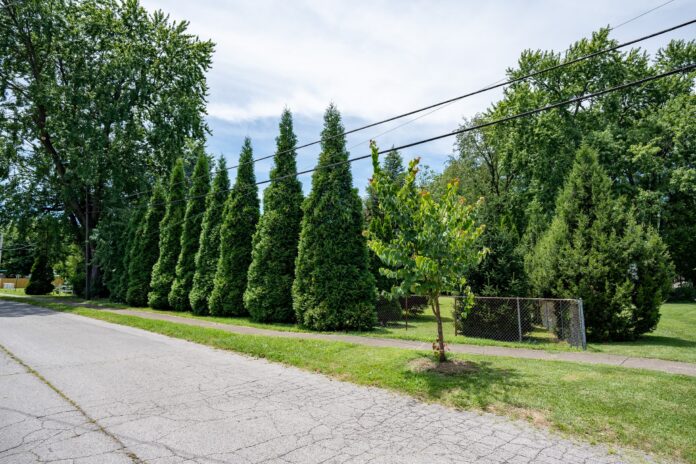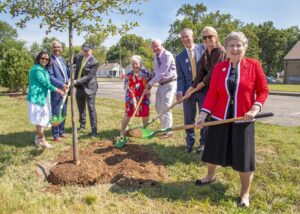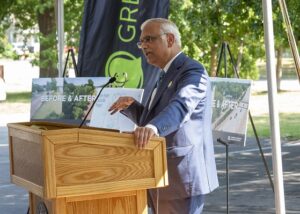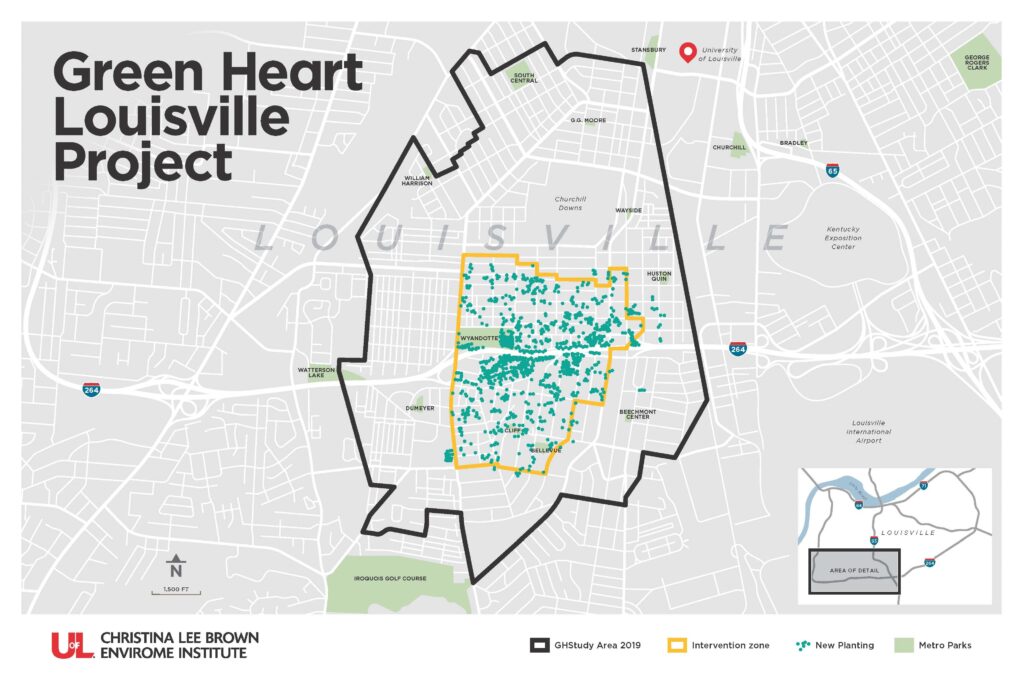
The University of Louisville’s groundbreaking Green Heart Louisville Project has found that people living in neighborhoods where the number of trees and shrubs was more than doubled showed lower levels of a blood marker of inflammation than those living outside the planted areas. General inflammation is an important risk indicator for heart disease and other chronic diseases.
The Christina Lee Brown Envirome Institute launched the first-of-its-kind project in 2018 in partnership with The Nature Conservancy, Washington University in St. Louis, Hyphae Design Laboratory and others to study whether and how living among more densely greened surroundings contributes to better heart health. The design of the study closely mirrors clinical trials which test whether medical treatments are effective. The team applied the treatment – the addition of large trees and shrubs – to some participants’ neighborhoods but not to others. They then compared residents’ health data to see how the addition of the trees affected their health.

“The Green Heart Louisville Project is an excellent example of how our university’s innovative and collaborative researchers are working to improve lives in our community and far beyond,” UofL President Kim Schatzel said. “Trees are beautiful, but these results show that the trees around us are also beneficial to individual and community health. Through this and many other projects, the Envirome Institute is improving health at the community level, not just for individuals, but for everyone living in a neighborhood.”
To understand the state of community’s health at the start of the study, researchers took blood, urine, hair and nail samples and documented health data from 745 people living in a four-square-mile area of south Louisville. The researchers also took detailed measurements of tree coverage and levels of air pollution in the area.
Following this baseline data collection, the Envirome Institute worked with The Nature Conservancy and a host of local partners and contractors to plant more than 8,000 large trees and shrubs in designated neighborhoods within the project area. Those living in the greened area were considered the treated population and the results obtained from this population were compared with residents of adjacent neighborhoods, where the project team did not plant any trees.
After the plantings, the research team reassessed residents’ health. They found that those living in the greened area had 13-20% lower levels of a biomarker of general inflammation, a measure called high-sensitivity C-reactive protein (hsCRP) than those living in the areas that did not receive any new trees or shrubs. Higher levels of hsCRP are strongly associated with a risk of cardiovascular disease and are an even stronger indicator of heart attack than cholesterol levels. Higher CRP levels also indicate a higher risk of diabetes and certain cancers.
A reduction of hsCRP by this percentage corresponds to nearly 10-15% reduction in the risk of heart attacks, cancer or dying from any disease.

“These results from the Green Heart Louisville Project indicate that trees contribute more to our lives than beauty and shade. They can improve the health of the people living around them,” said Aruni Bhatnagar, director of the Envirome Institute and UofL professor of medicine. “Although several previous studies have found an association between living in areas of high surrounding greenness and health, this is the first study to show that a deliberate increase in greenness in the neighborhood can improve health. With these results and additional studies that we hope to report soon, we are closer to understanding the impact of local tree cover on residents’ health. This finding will bolster the push to increase urban greenspaces.”
As more is known about the health impacts of increased tree cover, increased greening in cities may emerge as a key method to improve public health.
“Most of us intuitively understand that nature is good for our health. But scientific research testing, verifying and evaluating this connection is rare,” said Katharine Hayhoe, chief scientist of The Nature Conservancy. “These recent findings from the Green Heart Project build the scientific case for the powerful connections between the health of our planet and the health of all of us.”
Earlier in August, the Green Heart Louisville Project was awarded an additional $4.6 million in funding from the National Institute of Environmental Health Sciences to support continued research over the next five years.
These findings were presented by Daniel Riggs, UofL assistant professor of environmental medicine, at the 36th Annual Conference of the International Society for Environmental Epidemiology in Santiago, Chile on Aug. 26.
STUDY DETAILS
This study is part of the Green Heart Louisville Project, ongoing research to discover how trees and shrubs affect people’s health.
The neighborhood
The project involved a four-square-mile area of South Louisville straddling the Watterson Expressway, including the Taylor-Berry, Jacobs, Hazelwood, Oakdale, Wilder Park and Beechmont neighborhoods. The project team planted trees and shrubs in a central portion of the project area that included Wyandotte Park, which served as the treated area. They planted no trees in the outer areas of the project area. [SEE MAP]

The people
Researchers enlisted 745 people living in the project area to participate in the project’s ongoing health study. At enrollment, participants were between 25 and 75 years old, 60% female, 77% white and 50% had household income below $50,000 per year. They live in the planted intervention area as well as outside it.
Researchers collected participants’ blood, urine, nail and hair samples and health information before and after planting the trees and shrubs in the “treatment” area.
The trees
Between 2019 and 2022, the Green Heart Project planted 8,425 evergreen trees and shrubs of 42 different species from five different families and 630 deciduous trees. Evergreens were pine, cypress, yew, holly and magnolia. Deciduous trees were mainly dogwood, oak and serviceberry.
Project team members and BrightView Landscape maintain the trees to promote their survival, growth and sustained impact.
The data
High-sensitivity C-reactive protein (hsCRP) is a blood test that measures general inflammation in the body. After the planting, people living in the areas where trees and shrubs were added had 13-20% lower hsCRP levels compared with those living in the areas that did not receive greening from the project.
Inflammation as measured by hsCRP is an important risk indicator for heart disease, including stroke, heart attack and coronary artery disease. Previous studies have shown that hsCRP increases with age. The change in hsCRP seen in individuals living in the planted areas was similar to the difference between typical levels in a 42-year-old compared with a 33-year-old.
This difference also is similar to the difference between people who exercise regularly and those who do not. Finally, the decrease in hsCRP levels with planting corresponds to a nearly 10-15% reduction in the risk of heart attacks, cancer or dying from any disease.
Funding
A $3 million grant from the National Institute of Environmental Health Sciences supported the health evaluation of community participants and an additional $4.6 million was recently awarded for continuing this research. These grants bring the total investment by the institute to more than $8 million. The Nature Conservancy provided over $8.7 million in funding to support tree planting and maintenance, project management and other key project needs. The project has had an additional $3 million in support from local donors. Recently, $4.6 million in funding was awarded from the NIEHS for continued research over the next five years.
Collaborators and community partners
Collaborators for this project include the University of Louisville, Washington University in St. Louis, The Nature Conservancy, Hyphae Design Laboratory, the United States Forest Service, Louisville Grows and other partners.
Community organizations and resident involvement are vital to the success of this ongoing work to learn the health effects of urban greening. The team is grateful to the residents participating in the health study and those who have allowed tree planting on their property.
Watch a video about the research:
More:
View pictures from the Aug. 27 research results announcement on Flickr.
Watch the full Aug. 27 research results announcement on YouTube.
































